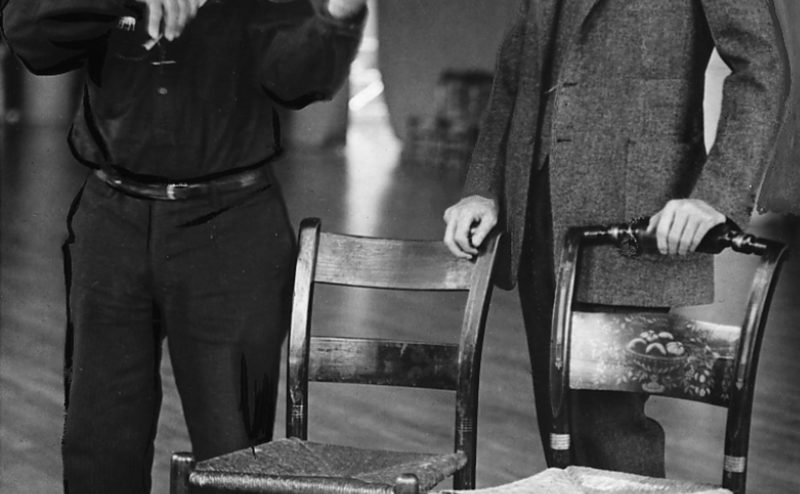
Visual History
Written by Cheryl Eagan-Donovan | Posted by: Anonymous
"I come to the world of archives as a producer," Steve Alves explained, introducing the company he works for, Footage Farm, to a group of documentary filmmakers. He spoke at the Coolidge Corner Theatre, where Connect the Docs, a support group for Boston based professional filmmakers, meets monthly.
"I have always loved archives. When I became a producer of documentaries, back in 1988, I would ask ‘what other material can I bring to this story?’" To demonstrate the effective use of archival footage, Steve showed a clip from his film about the history of contra dancing, and another from his most recent film Talking to the Wall: The Story of an American Bargain. The first film required the creative integration of still photos and also featured some wonderful footage of Henry Ford square dancing. With a budget of $10,000 for archival footage, Talking to the Wall included material from six different film sources.
"There are many types of archival materials," Alves continued. "Hollywood films can be very expensive. Getty Images has taken over a huge amount of archives, including acquisition of the company Archive Films. Today, the rates for archival footage are about $50-$85 per second. As a result, producers try to find as much material as possible in the public domain. The National Archives in Washington D.C. is the greatest resource for this footage, but the process is very formal and time-consuming."
Researching what is available can cost up to $300 per day, and it can take up to five weeks to get the material. That is where Footage Farm comes to the aid of filmmakers.
Founded by Orly Yadin in 2001, Footage Farm is a London based company that recently entered the North American market through a partnership with Green Mountain Post Films. Its mission, to provide quality masters of Public Domain material to producers at low cost, is what sold Alves on the company. Instead of a per-second rate, the company charges a one-time buy-out fee. "The database allows a producer to request material on any subject, with an average turnaround time of 24-72 hours for master tapes." Once a filmmaker purchases a master, the material can be used as many times, in as many different projects, as needed with no additional fees.
The material is sold on a source-reel basis, just like it is through the National Archives. Source reels average between six and 11 minutes in length and the cost per master reel ranges from $350 for one to $160 each for 11 or more. Accessibility and fast turnaround are key. "That’s why big companies like Arts & Entertainment (A&E) Television like this service," Alves explained. Other clients include many independent film producers, public television stations, Merchant Ivory Productions, and Kenn Rabin, one of the leading archival researchers in the country, who worked on the award winning series Eyes on the Prize.
The collection spans more than a century, with films from late 1800s through the 1980s. Sources include Universal Newsreels, United States government films, and the Ford Collection industrial films. Also included in the Public Domain collection are some of the earliest recorded events in U.S. history including the Spanish-American War, the Alaskan Gold Rush, and the San Francisco 1906 earthquake. Private collection materials include educational and industrial films from the United Kingdom, Israel, and the former Soviet Union. Through the partnership with Green Mountain Post, Footage Farm also offers films from the Vietnam era, films on the environment, and concert footage.
"I’m here as a filmmaker," Alves repeated, and went on to discuss various archival search engines. He offered the group some general advice on acquiring privately held archival footage, based on his more than 20 years experience as both an editor and a producer. "The general rule is to figure out what rights you needs in the beginning of the process. It’s a negotiation game," he explained. Getting all rights, worldwide and in perpetuity, is almost impossible today, he cautioned.
While high profile, big budget documentaries can afford to pay per-second rates, he suggests independent producers seek alternatives to dealing with big holding companies like Getty. For example, one approach is to try and reach a deal where the filmmaker pays only for the footage used. Again, Alves cites Rabin as his mentor on the subject. "I took a workshop with Kenn Rabin in 1994, where he said that it’s better to get all of your material from one source if possible. That allows you to negotiate a substantial discount," Alves concluded.
Alves then treated the assembled filmmakers to a wonderful sampling of Footage Farm’s collection. First we saw South Dakota Native Americans on the prairie. Audience members wondered aloud who shot the footage, and how much was staged. Next we saw the Buffalo New York Police Department in an 1897 parade, then Martha’s Vineyard at the time of the Lindbergh kidnapping. We were transported to the Lower East Side of New York in 1932, then to Teddy Roosevelt’s Amazon Expedition. We watched as United States Armed Services women marched in a ceremony for Madame Chiang Kai-shek, and then relived the tragic1937 Hindenburg explosion.
One of the highlights of the collection was a film about the 1939 New York World’s Fair and its "World of Tomorrow," aptly titled Life as We Know It. Equally entertaining were the "mental hygiene" films produced from 1947 until 1968 by Coronet Instructional Films. These social education films captured a time in our cultural history that seems quaint and innocent by today’s standards. After taking a break to allow audience members a chance to search Footage Farm’s database on his laptop, Alves brought out his pièce de résistance, the 1979 Bruce Springsteen appearance from the concert film No Nukes.
Alves explained his passion for film. "To me, archives are vivid, living treasures. I look at this footage and immediately start of thinking of the film that I could make based on the material." Many of the filmmakers in the audience had the same response. Each clip provided an impetus and engaged our imaginations. Here, courtesy of Footage Farm, was a century of stories waiting to be told.
To learn more about Footage Farm Archive, contact Steve at salves@footagefarm.com or visit the website at www.footagefarm.com. For more on Steve’s films, visit www.talkingtowall.com, or contact Hometown Productions at hometown@crocker.com. For more information on Green Mountain Post Films, visit http://www.gmpfilms.com/. Cheryl Eagan-Donovan is a documentary filmmaker and writer based in Boston and can be reached at www.controversyfilms.com. Her second feature, Nothing is Truer than Truth, is in preproduction.










